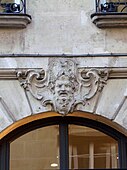Cartouche (design)
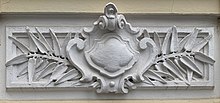
| Look up cartouche in Wiktionary, the free dictionary. |
A cartouche (also cartouch) is an oval or oblong design with a slightly convex surface, typically edged with ornamental scrollwork. It is used to hold a painted or low-relief design.[1] Since the early 16th century, the cartouche is a scrolling frame device, derived originally from Italian cartuccia. Such cartouches are characteristically stretched, pierced and scrolling.
Another cartouche figures prominently in the 16th-century title page of Giorgio Vasari's Lives of the Most Excellent Painters, Sculptors, and Architects, framing a minor vignette with a pierced and scrolling papery cartouche.
The engraved trade card of the London clockmaker Percy Webster shows a vignette of the shop in a scrolling cartouche frame of Rococo design that is composed entirely of scrolling devices.
Gallery[]

Roman rectangular cartouche on the base of the Obelisk of Theodosius, Istanbul, Turkey

Brâncovenesc cartouche on a damaged stone in the courtyard of Antim Monastery, Bucharest, Romania

Two Renaissance cartouches, a big one with Alexander the Great and a smaller one with an inscription, 1574-1637, the Rijksmuseum, Amsterdam, the Netherlands
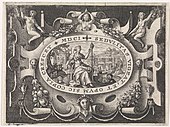
Renaissance cartouche, 1601, Rijksmuseum

Baroque cartouche, with festoons, cornucopias and mascaron, 1645, the Metropolitan Museum of Art

Design of a Baroque cartouche, by Stefano della Bella, 1647, the Cleveland Museum of Art, Ohio
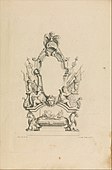
Etching of a complex Baroque cartouche, by Bernard Turreau, 1716, the Metropolitan Museum of Art
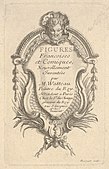
Baroque Frontispiece for Figures françoises et comiques by Robert Hecquet, 18th century, the Metropolitan Museum of Art
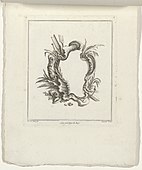
Rococo cartouche from the Second Livre de Cartouches, circa 1710-1772, Rijksmuseum
Rococo cartouche with a mascaron in it, on the facade of house no. 404 on Rue Saint-Honoré (Paris)

Louis XVI style cartouche with festoons, based on a Greco-Roman came, circa 1770, Metropolitan Museum of Art
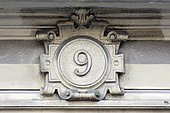
Renaissance Revival cartouche on Rue des Archives in Paris

Rococo Revival stucco with cartouches in the corners, on a ceiling of the Cantacuzino Palace, Bucharest

Romanian Revival cartouche above a window of house no. 60 on Bulevardul Dacia, Bucharest

19th century Eclectic Classicist cartouche with a mascaron, above the entrance door of the Académie d'Agriculture de France in Paris
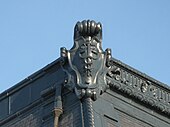
19th century Eclectic Classicist cartouche with a caduceus, on the roof of the Crédit Lyonnais headquarters, Paris

19th century Eclectic Classicist rectangular cartouche of the Printemps Haussmann, Paris

19th century Eclectic Classicist cartouches in and under a pediment of Hala Traian, Bucharest. The rectangular one is a revival of Ancient Roman ones, that had the exact same shape
Beaux-Arts cartouche of the Pont Alexandre III, Paris

Three designs of Art Nouveau cartouches

Complex Art Deco cartouche in the New York State Museum, Albany, New York
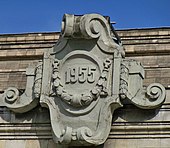
Stalinist cartouche of the Palace of Culture and Science, Warsaw, Poland
See also[]
- Tondo (art): round (circular)
- Medallion (architecture): round or oval
- Architectural sculpture
- Cartouche (cartography)
- Resist: a technique in ceramics to highlight cartouches, etc.
Footnotes[]
External links[]
| Wikimedia Commons has media related to Cartouches. |
- Ornaments
- Decorative arts
- Architectural elements
- Ornaments (architecture)











